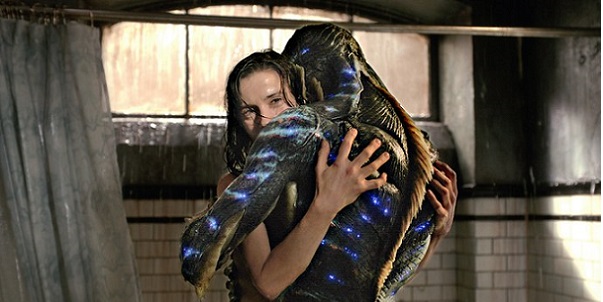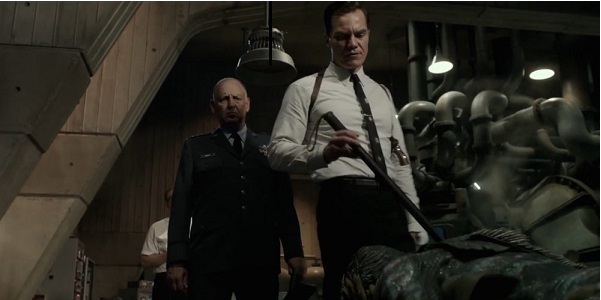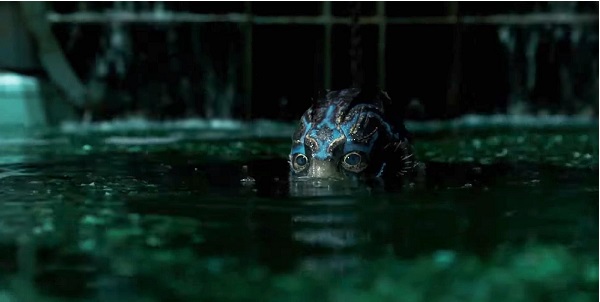The Shape Of Solidarity: Guillermo Del Toro’s Vision For America

Hazem Fahmy is a poet and critic from Cairo. He…
Going in, I knew little to none about Guillermo Del Toro’s Pan’s Labyrinth. I had seen snapshots of the film: the Pale Man and the Faun, the Post Spanish Civil War setting, the little girl wandering through scenes of magic and terror – but I was not prepared for the sheer punch of the film; its seamless, ultimately haunting, blend of history and fantasy. I was always aware of Del Toro’s masterful penchant for production design and visual splendor (having had seen his more mainstream work like Hellboy, Pacific Rim, and Crimson Peak), but Pan’s Labyrinth left me with a much more potent sense of awe, born out of the film’s impeccable balance of fairytale grandeur and political grit.

In The Shape of Water, Del Toro not only manages to rebuild that impeccable balance, but also crafts out of it a story that is as much of the past as it is of the present and future. Pan’s Labyrinth’s exploration of the power of fantasy to heal and give reason, as well as its overt condemnation of fascism, is by all means timeless, but The Shape of Water’s sociopolitical framework, its incisive retrospective on mid-century America, is firmly rooted in our present anxiety. He lures us in with cute nostalgia – grand cinemas, pie shops, hand-drawn ads – only to smack us with the realities of American racism, misogyny, homophobia and ableism that we are (still very much) trying to overcome.
On par with Del Toro’s body of work, the film’s plot and look is a splendid pastiche of genre and influences, drawing as much from Studio Era horror as it does from pulp comic books and cold war thrillers. Del Toro is by no means a stranger to such audacious combinations, but The Shape of Water kicks it up a few notches while maintaining the director’s signature equilibrium. This is in large part thanks to the rich specifity given to each character, especially Elisa, whose world and routine we are quickly grounded in.
Likewise we get to know Giles and Zelda very quickly, as rounded people before marginalized people. In this way, the film resists tokenization by giving us a diverse set of characters to get acquainted with and eventually root for. The sheer pathos each of Sally Hawkins, Richard Jenkins, and Octavia Spencer bring to their respective characters, and to one another, of course helps.
Monsters and Men
In the center of Del Toro’s ambitious unraveling of American violence is the Amphibian Man, the gorgeous, nameless creature who proves himself a god by the end. In him, Del Toro gives his characters a cause behind which they unite and mobilize. Just as in Pan’s Labyrinth, Del Toro creates a sharp contrast between the fantastical monster and the real monster – in Pan it’s Captain Vidal, here it’s Colonel Strickland.
This is perhaps the feat most responsible for crowning Del Toro the master of the modern movie monster. Beyond brilliant designs and a consistent, yet spectacularly diverse, aesthetic, no other contemporary director is as skilled at rendering our fears and hopes in otherworldly creatures.
There has been (totally justifiable) concern that the film’s use of a fantastical creature for social commentary, especially with regards to disability, plays into a problematic history of associating the marginalized with nonhuman characters – think Planet of the Apes or the early days of the X-Men – but I’d argue the film, to varying degrees of success, subverts that trope by challenging the very idea of what makes a monster. In everything from his presentation to his relationship with the rest of the cast, the Amphibian Man represents the exploited other; marginalized solely for the white man’s ability to dehumanize him.
That said, nonhuman motifs of oppression are, of course, always tricky, and the film is not without its stumbles. One of its more obvious is in Elisa’s monologue to Giles, when she attempts to convince him to save the Amphibian Man. What starts off as a powerful plea for compassionate action quickly gets into iffy territory when Elisa (who was neither written by writers who are mute nor portrayed by an actor who is) talks about how the Amphibian Man “does not know that she is incomplete,” a defeatist look at disability that several advocates have already slammed. But rest assured, The Shape of Water is no Bright.
Though by no means perfect, Del Toro’s intersectional lens of the Sixties is incredibly uncommon for mainstream American media, and is, at the very least, a welcome step forward for how we understand and depict systems of violence.

Not one moment after his appearance, Colonel Strickland (played with precise menace by Michael Shannon) makes it crystal clear who the true beast is. With his long shock stick, as much a motif of violent masculinity as it is of racialized police brutality, and longer rambles about man and the Bible, Strickland is the embodiment par excellence of the far-right, jingoistic, entitled American man. Though some of his scenes played a little too close to being ham-fisted (for example, his fetish of Elisa’s muteness), they nonetheless did their job in establishing him as a truly terrifying force; one who arrests our attention and fear the moment he appears on screen.
But more so than the militaristic, over-powered and resourceful Strickland, The Shape of Water shows us the mundane monstrosity of America. We see this specifically in Giles’s brief, but deeply resonant arc with regards to Elisa’s plan. When she first informs him of her intention to break out the Amphibian Man, he is immediately afraid of the mere prospect of stepping a toe out of line. This is the only moment in the film where we see any other character but Strickland and the General actively dehumanize the Amphibian Man. Giles does so because he is afraid, because admitting his humanity means facing his own conscience, and thus his inevitable moral obligation to help Elisa save him.
All or Nothing
Giles changes his mind after a devastating incident in the pie shop, when the handsome clerk he had developed feelings for throws him out for coming on to him. In a flash, the man shows Giles his true colors, viciously rejecting him right before he cruelly prevents a black couple from entering the shop. When ordering Giles to leave, the man utters what is perhaps the single most popular catchphrase of racists and homophobes all across the nation: “this is a family restaurant.”
In addition to the humiliating way with which the clerk rejected him, this situation acts as a major blow to Giles because it exposes the absurdity of his own complacency. He is reminded that he cannot simply switch the TV from footage of police brutality to show tunes. If he seeks his own liberation, he must fight for others as well.

Beyond the unhinged race for victory in the Cold War, the battle for the Amphibian Man is one of compassion – Elisa, Giles, Zelda and Dmitri have it, Strickland does not. One of the finest moments of irony in cinema over the last year comes in Strickland’s horrific confrontation of Dmitri, when he discovers that the two women he had belittled, threatened and harassed have completely bested him. Earlier, in one of the funniest lines of the film, David Hewlett’s perpetually bumbling Fleming confidently states that the Amphibian Man could only have been broken out by a foreign planted black ops team with at least ten members and months of preparation.
Such a hilariously inaccurate conclusion, paired with Strickland’s complete shock at Dmitri’s revelation, don’t just speak to these men’s misogyny and racism – their complete underestimation of Elisa and Zelda – but also to their complete inability to understand why anyone would break out the Amphibian Man for any reason beyond political and military gains.
This is where The Shape of Water stresses its solidarity between the marginalized the most. In Elisa, Giles, and Zelda’s commitment to get the Amphibian Man out of harm’s way, we see the heightened compassion those who are othered often display for one another, in sharp contrast to the belligerently privileged and powerful who often cannot find it in them to extend humanity to others lest they risk their own fragile sense of superiority. If ever Giles or Zelda hesitated in their plan, it was solely out of a momentary (and understandable) fear of reprisal, not a genuine desire to dehumanize the Amphibian Man.
Del Toro’s Vision of America: Conclusion
It is only right before his deeply satisfying demise that Strickland is finally able to acknowledge the Amphibian Man, but even then it is in terms of his power. Elisa doesn’t fall in love with him because of his supernatural abilities, she does so because she finds a kindred spirit in him. In Elisa, we see the power of unconditional compassion; the untamed desire to connect and share with others, to not leave anyone behind, no matter how scary fighting for them may be.
It is through this dedication of hers that Del Toro charts a course for America’s future; one in which we must find the strength within ourselves to stand up for the most vulnerable among us, especially when we think we are safer than them. In an age of deportations, Neo-Nazi marches, and continued military bravado, we have no other choice. Only solidarity will set us free.
How did you relate to the Amphibian Man?
Does content like this matter to you?
Become a Member and support film journalism. Unlock access to all of Film Inquiry`s great articles. Join a community of like-minded readers who are passionate about cinema - get access to our private members Network, give back to independent filmmakers, and more.
Hazem Fahmy is a poet and critic from Cairo. He is an Honors graduate of Wesleyan University’s College of Letters where he studied literature, philosophy, history and film. His work has appeared, or is forthcoming in Apogee, HEArt, Mizna, and The Offing. In his spare time, Hazem writes about the Middle East and tries to come up with creative ways to mock Classicism. He makes videos occasionally.













